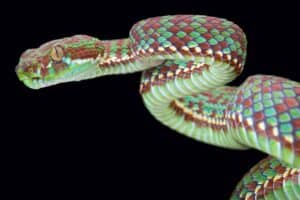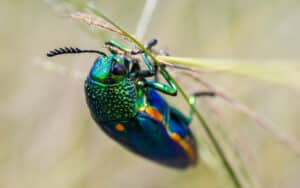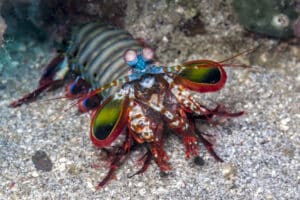13 Animals That Can Sense Things Humans Can’t
Estimated 0 min read
 It’s hard not to get depressed about how limited humans’ abilities are compared to other animals. Heck, we can’t even smell as well as dogs can, let alone do something crazy such as detect electrical charges of other animals …as the humble bumblebee can!.
It’s hard not to get depressed about how limited humans’ abilities are compared to other animals. Heck, we can’t even smell as well as dogs can, let alone do something crazy such as detect electrical charges of other animals …as the humble bumblebee can!.
Animals have evolved to experience parts of the world we simply can’t even perceive. Of course, some of these enhanced capabilities aren’t exactly pleasant (we certainly wouldn’t want to be able to detect electrical charges), but are cool experiences nonetheless. Here are thirteen animals with some pretty unique senses that we’re intrigued by.
Platypus

Wouldn’t you think that a mammal who has a duck’s bill and webbed feet is a bit out of the ordinary? Well, that’s because platypuses are truly one of nature’s anomalies. Without even mentioning that they’re one of the only mammals that can lay eggs, they just… lookoff.
Though their bodies might look strange, platypuses’ anatomy actually conceals a hidden, powerful tool.Inside of their bills are billions of sensors which they use to detect the electrical impulses of their prey. Yeah… platypuses went from being funny-looking to scary-soundingreallyquickly, didn’t they?
Vampire Bats
Who doesn’t hate it when a nurse tries to stick you with a needle and then can’t find the vein? Well, this would not be a problem if every phlebotomist was a vampire bat!
This is because vampire bats have the ability to sniff out TRPV1 proteins from the air. What are TRPV1 proteins? they are the proteins in our noses that our brains use to detect when something is too hot. However, vampire bats use this protein-alert to notify them when they’re hovering over warm skin (skin that’s likely hiding a blood vessel!).
Pit Vipers

Pit vipers are like the SWAT team members of the jungle – they’re always ready to kill. Part of the reason for that analogy is that their bodies are just uniquely designed to hunt.
Not only are they incredibly agile creatures who pack a ferocious bite, but they also have a hidden sense. Beneath each of their nostrils are two small slits – otherwise referred to as ‘pits’.
These pits act as a pair of eyes that can seeinfrared light.
This is pretty insane when you consider that humans can only feel infrared energy as heat. This means that these snakes can use the visual differences in temperature variations of an object to determine whether or not it’s prey.
Octopuses
That’s right – it’s octopuses, not octopi. Of course, an octopus would never make that kind of simple spelling mistake. They’re way too perceptive for that. Part of the reason for this is purely to do with their eyes.
Octopuses’ eyes have polarized vision, meaning they can control the amount of light coming in. This gives octopuses the ability to see well while in dark water or at lower depths.
Catfish
Believe it or not, catfish is the tastiest fish around – and somehow that’s a double entendre!Catfish have over 175,000 taste-sensitive cellswhich is more than 15X a human’s 10,000 taste buds. Not only does these extra taste buds help the whisker-faced fish taste its food better, but it also allows them to locate prey nearby more easily.
African Bush Elephants

Believe it or not, African Bush Elephants use their trunks for more than just picking up food and eating it! Wait, you knew they used it to sniff things, too? Well, did you know that its trunk has 2000 powerful scent receptors (more than five times the number of scent receptors that humans have)?
Not only that, but elephants have an insanely elevated sense of touch. Their feet and trunks are sensitive enough that they can detect the low, rumbling vibrations of elephants from ten miles away. Even more cool is that elephants use these vibrations to communicate critical information, such as the presence of food or predators. And further up the cool chart, elephants can use the subtle differences in How the vibrations sound to tell if the speakers themselves are friendly or not.
Jewel Beetles

The five senses are taste, touch, smell, sight, and hearing, right? Well, what if there was a sixth sense and (hear us out) what if it was fire? Yeah. That’s the reality of the jewel beetle. These beautiful little bugs can smell and detect a burning pine tree that is ten miles away!
The reason these tiny critters have such overpowered abilities to detect the presence of fire is because of their kids! When a jewel beetle detects a fire nearby, it knowsit must go quicklyto the nearest burning bark to lay its eggs. This way its offspring can grow up without competition.
Imagine wanting your kid to succeed so badly you ran towards a fire to prepare her nursery!
Honey Bees
If it’s cool that jewel beetles can detect fire, then it must be mind-blowing to know honey bees can detect the earth’s magnetic field. “Umm… not really,” you might say. “Birds can do that too.”
Well, that’s true. However, what’s amazing about honey bees is that scientists still aren’t surehowthey do that. Currently, it’s believed some cells in honey bees’ abdomens are lined by a magnetic mineral called magnetite. This magnetite essentially acts as a compass that always tells honey bees which way points north. However, some argue that it’s actually the sun which gives honey bees this ability.
Not only can honey bees detect the earth’s magnetic field, but they can use this knowledge of electromagnetic waves to detect when thunderstorms are approaching.
Bumblebees
 While honey bees spend their time detecting magnetic waves, bumblebees are over here detecting the charges on objects. While bumblebees are in-flight, their bodies pick up a mild positive charge. Plants and flowers, on the other hand, have a negative charge as they just sit there.
While honey bees spend their time detecting magnetic waves, bumblebees are over here detecting the charges on objects. While bumblebees are in-flight, their bodies pick up a mild positive charge. Plants and flowers, on the other hand, have a negative charge as they just sit there.
Mechanosensory hairs on the bumblebees’ legs alert them to an opposite magnetic charge in their flying vicinity, thus guiding them to a bloom. What’s even more fascinating is that the flower’s charge changes once a bee stops on it. This prevents other bees from landing on it.
Spiders
Here’s a fun fact: most spiders are hyper-sensitive to touch. Spiders have a ton of hairs on their legs which let them detect and source the origin of vibrations created by other animals or objects. This is part of why they build webs and just hang out in them all day – they just let other animals’ movement do the work of hunting for them.
Unfortunately, this insane sensitivity also means that spiders probably feel every second of pain when we kill them…
Mantis Shrimp

If you thought that octopuses had a hyper-charged sense of sight, wait until you hear about the mantis shrimp. These little sea bugs have the most complex visual system in the animal kingdom thanks to their 16 photoreceptors. These photoreceptors allow them to detect visible light, or, ultraviolet light, and many other types of light!
Most incredulous is that mantis shrimp have patterns on them that are only detectable in certain moments when the light’s polarization has rotated clockwise or counterclockwise. Unfortunately, there’s only one type of animal that can detect this circularly polarized light. Fortunately, that animal is actually the mantis shrimp! So, mantis shrimp have evolved to tell the difference between the circular polarization patterns that are used for mating or other types of signaling.
Roundworms
Even the lowest-level organisms need to be able to detect things around them. Roundworms are no exception! Just as bees and birds, roundworms rely on their ability to detect the Earth’s electromagnetic field to orient themselves. However, due to their teeny size, roundworms’ internal compass is only a single cell large.
Harbor Seals

You know how some people say that you should run in zig-zags if someone were chasing you? Yeah, this would not work against a harbor seal. That’s because harbor seals have about 80 longer whiskers attached to their faces, each of which has thousands of sensory receptors. These receptors allow them to detect the path of a fish long after the fish has fled to a supposed safety zone or place. We guess you could call this sense of… motion?
Now, although we humans don’t have a sense for motion or magnetic fields or electrical charges, but there is one thing we do have a special sense for. We know that you want to learn more about how to keep your pet happy and healthy. That’s why we hope you’ll read some of our latest releases from our top-performing pet health blog, such as this article about how toprevent cracked dog pawsor any number of other intriguing articles in ourBanixx Dog Blog. For example, have you ever wondered how long adog can go without peeing? We have that answer too!
Sources
https://www.nature.com/articles/news.2010.122
https://gf.nd.gov/wildlife-notes/catfish-taste-receptors
https://www.science.org/content/article/borrowed-beetles
https://www.reed.edu/biology/professors/srenn/pages/teaching/web_2007/myp_site/#:~:text=Platypuses%20are%20unusual%20creatures%20with%20unusual%20abilities.&text=Electroreception%20allows%20platypuses%20to%20use,deepest%20and%20darkest%20of%20waters.&text=Electroreception%20conferred%20by%20this%20%E2%80%9Cbill,navigation%20through%20light%2Dlimited%20areas

















